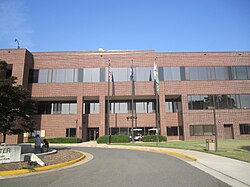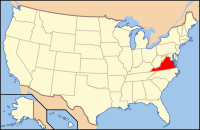Prince William County
| Prince William County, Virginia | |||
|---|---|---|---|
| County | |||
| Prince William County | |||

The Prince William County Courthouse in Manassas in July 2011
|
|||
|
|||
| Nickname(s): "P.W. County" | |||
 Location in the U.S. state of Virginia |
|||
 Virginia's location in the U.S. |
|||
| Founded | 1731 | ||
| Named for | Prince William, Duke of Cumberland | ||
| Seat | Manassas | ||
| Largest town | Dumfries | ||
| Area | |||
| • Total | 348 sq mi (901 km2) | ||
| • Land | 336 sq mi (870 km2) | ||
| • Water | 12 sq mi (31 km2), 3.5% | ||
| Population (est.) | |||
| • (2015) | 451,721 | ||
| • Density | 1,298/sq mi (501/km²) | ||
| Congressional districts | 1st, 10th, 11th | ||
| Time zone | Eastern: UTC-5/-4 | ||
| Website | www |
||
Prince William County is a county on the Potomac River in the Commonwealth of Virginia. As of the 2010 census, the population was 402,002, on 1 July 2015, the population was estimated to be 451,721, making it Virginia's second-most populous county. Its county seat is the independent city of Manassas.
A part of Northern Virginia, Prince William County is part of the Washington-Arlington-Alexandria, DC-VA-MD-WV Metropolitan Statistical Area. In 2012 it had the seventh highest income of any county in the United States. It was Virginia's first majority-minority county, with Hispanic (of any race, mostly from Central and South America), African American, and Asian the chief groups.
The Bureau of Economic Analysis combines the independent cities of Manassas and Manassas Park with Prince William County (within which the two cities are enclaves) for statistical purposes:
At the time of European encounter, the main inhabitants of the area that would become Prince William County were the Doeg, an Algonquian-speaking sub-group of the Powhatan tribal confederation. When John Smith and other English explorers ventured to the upper Potomac River beginning in 1608, they recorded the name of a village the Doeg inhabited as Pemacocack (meaning "plenty of fish"). It was located on the west bank of the Potomac River about 30 miles south of present-day Alexandria. Unable to deal with European diseases and firepower, the Doeg had abandoned their villages in the area by 1700.
...
Wikipedia


